Extraterrestrial Fun from Home
- By Faith Tucker
- August 19, 2011
- Comments Off on Extraterrestrial Fun from Home
We here at Blueshift do our best to cover all things astrophysics, which we rather loosely define as ‘anything and everything outside the Solar System.’ Considering that the Universe just happens to be an absolutely enormous place filled with innumerable galaxies, each containing billions of stars, planets and other objects, that’s a whole lot of ground to cover! And yet, even with our just about literally unlimited fodder for astrophysical blogs and podcasts and round-ups, our content still remains closely connected to the other branches of science research here at NASA, like the big happy family we are. Heliophysics gives us an unparalleled look into the intricacies of the life of a star by studying the Sun in unprecedented detail (just check out the amazing things SDO and other great missions are doing). Earth Science shows us just how connected our home planet is to it’s surroundings, both near and far. And Planetary Science furnishes us with a fascinating look into the formation of planetary systems and other planetary phenomena that are invaluable when studying planetary systems around distant stars.
So, in the spirit of NASA unity, today’s interdisciplinary subject involves a little NASA science intermingling as we look at how geology plays into Planetary Science. But, this planetary adventure won’t actually involve any interplanetary travel. Instead we’re just going to skip over to the island paradise of Svalbard, Norway to see how NASA planetary scientists use geology right here on Earth to learn about distant worlds that humans can’t visit just yet.
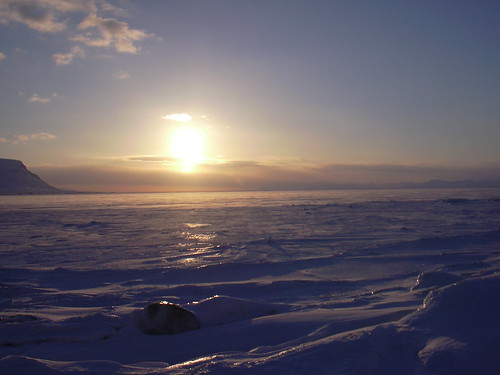
The island paradise of Svalbard, credit: welcome_to_nunavik
*Note: by ‘island paradise’ I mean arctic archipelago residing about half way in between Norway and the North Pole*
Unlike Astrophysics, Planetary Science has the benefit of actually being able to send orbiters, probes and landers to other planets and objects in our Solar System to investigate them up close, sometimes even bringing back samples to study in a laboratory. If only we could run over to the nearest black hole or Gamma Ray Burst, the Universe might make a lot more sense! But even with the proximity, planetary scientists are still limited in the research they can do on their distant test subjects. So these resourceful scientists make use of the planet they do have unlimited access to (hint: you’re standing on it) by studying some of the extreme climates here that resemble those on other planets, known as terrestrial analogs. I got a chance to talk with Dr. Amy McAdam who’s currently braving the icy cold summer breezes of Svalbard with the Arctic Mars Analog Svalbard Expedition (AMASE) about the use of terrestrial analogs to study distant worlds.
Here’s what she had to say about the exciting world of terrestrial analogs and planetary geology:
Even with orbiters, probes and landers traveling to other planets, our understanding of the the Solar System depends heavily on our understanding of our planet and terrestrial analogs. What can (and can’t) we learn about other planets from right here on Earth?
I think we can learn a lot about other planets from here on earth. Terrestrial analog settings can’t consider some important environmental aspects of another planet, the extreme cold and dry or the low atmospheric pressure at the current Martian surface, for example, but as long as we consider these differences as compared to terrestrial analogs we can still learn a lot. For example, we can go to the very cold, dry Antarctic. This setting is not as cold and dry as the surface of Mars, but there are similarities, and we can learn about potential Martian surface processes by studying Antarctic processes. We just have to keep in mind which features we might expect to be most different because of the different environmental conditions.
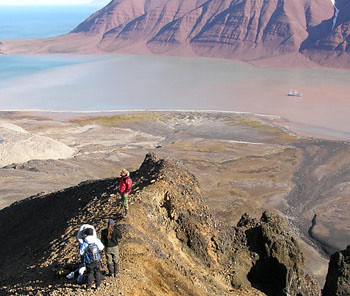
AMASE scientists working on Sverrefjell looking over the R/V Lance below in Bockfjorden.
Credit: NASA/AMASE/Kirsten Fristad
Why are terrestrial analogs an important part of planetary science?
I think terrestrial analogs are an important part of planetary science because you can go to a planetary-like system and characterize with all the robustness needed to fully understand a feature or process that helps you understand a planetary problem. You can see the site with your own eyes, experience the environment, really get a feeling for what is going on. And you can bring samples back to the lab, and characterize with state-of-the-art techniques.
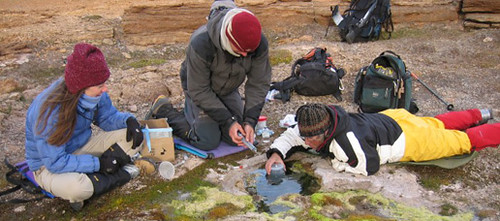
Kirsten Fristad, Ivar Midtkandal and Marilyn Fogel collect gas samples at Troll Springs in Bockfjorden.
Credit: NASA/AMASE/Kirsten Fristad
What will your AMASE team be working on and hoping to achieve during this expedition?
AMASE this year will be going to several sites about Svalbard Archipelago to characterize the Mars analog materials there and address a variety of scientific questions. The sites cover a range of environments, including several environments which contain materials with characteristics similar to those observed in the Gale Craters, the recently chosen landing site for the Mars Science Laboratory rover due to land on Mars in August of next year. These materials will include clay and sulfate salt bearing rocks, which have been a major focus interest at Gale Crater. They will also include basalts, some of which contain carbonates that are among the best analogs in the world to the well-known carbonate globules within the Martian meteorite ALH84001.
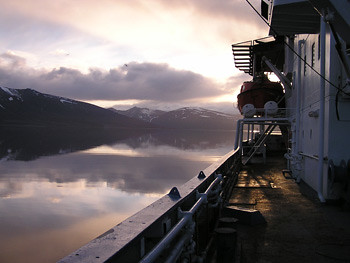
The 1 am sun glancing off the water in Bockfjorden.
Credit: NASA/AMASE/Kirsten Fristad
What is a typical day in the life on expeditions like this?
For me, a typical day on AMASE will include fieldwork or laboratory work on the research vessel (the R/V Lance). If going into the field, we don safety suits and head out on a zodiac from the larger vessel to the shore. [From] there we will hike up to our target analog site or sites and collect samples of rocks and soils. Some AMASE members will bring their instruments into the field as well and perform analyses of their samples there in the field. The main instrument I work with is not field-portable, so I will typically collect samples carefully and bring them back to the ship for analysis there.

Rough seas in the Arctic Ocean with mountains and glaciers in the distance.
Credit: NASA/AMASE/Kirsten Fristad
According to the AMASE website, “Interdisciplinary research is needed that combines molecular biology, ecology, microbiology, geology, physics, astronomy, information science and space exploration technologies. The broad interdisciplinary character of astrobiology compels us to strive for the most comprehensive and inclusive understanding of biological, planetary and cosmic phenomena.” Does your research include any particularly exciting or unexpected interdisciplinary overlaps?
I get to work on many interdisciplinary projects at Goddard, which is one of the many things I greatly enjoy about working there. Being on the SAM [Sample Analysis at Mars] team, I am involved in projects with colleagues who do isotope work, characterization of the organic chemistry of samples, and the mineralogy and petrology of samples. An aspect I am particularly fascinated with is the associations between organic materials and minerals in natural samples, and how this might help us understand analyses on Mars.
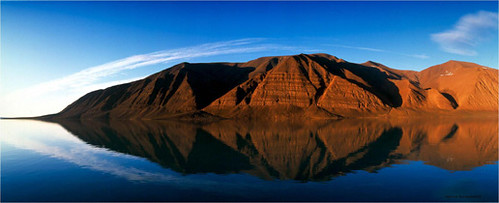
Panoramic image of the Redbeds in Bockfjorden, Svalbard. Layered sediments in northern Svalbard that may be similar to layered sedimentary deposits on Mars.
Credit: Kjell Ove Storvick/AMASE
So there you have it, sometimes learning about distant planets starts with the very dirt below out feet, at least if you happen to be on a glacial island in the Arctic Circle. However, the study of terrestrial analogs isn’t just for planetary scientists: the more we learn about planetary systems and geological phenomena in our own Solar System the better we can understand exoplanets orbiting distant stars. And that, my friends, means geology also plays into astrophysics in its own unique way. Plus, it makes astrophysicists who utilize geology bona fide rockstars (badum-ching!).



